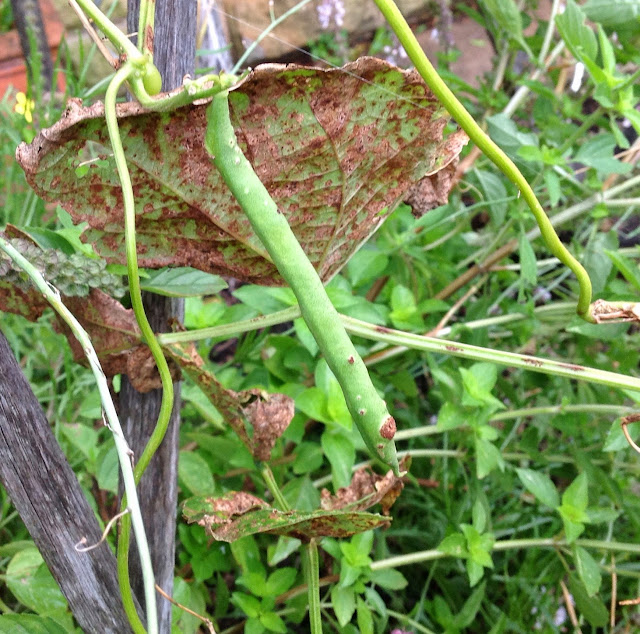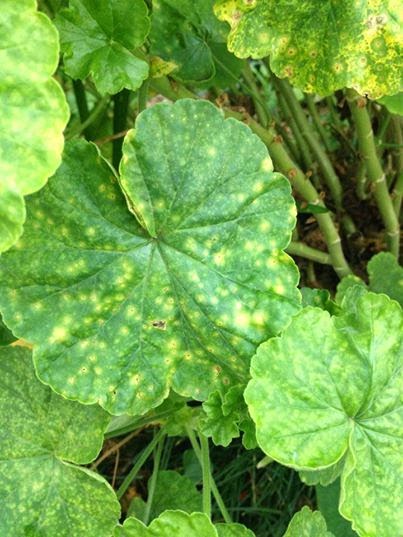PLANT DOCTOR
Did you know that rusts are amongst the most common fungal diseases of garden plants?
 |
| Rust on all parts of the bean plants |
Rust diseases are unsightly and often (but not always) reduce plant vigour.
In extreme cases, rust infection can even kill the plant.
Listen to these solutions to rust on your plants. I'm talking with General Manager, Steve Falcioni from www.ecoorganicgarden.com.au
Rust can effect many different garden plants, and for the most part, each plant has a specific type of rust that won't transfer to a different type or genus of plant.
 |
| rust on Pelargonium leaves |
Pustules may be orange, yellow, brown, black or white in colour.
Rust is caused by fungus, and rust can happen at any time if you’ve the right conditions and climate but is seen mainly in mid- to late summer and autumn.
If you have any questions about rust on your plants or have a photo to send it, drop us a line to realworldgardener@gmail.com or write in to 2RRR P.O. Box 644 Gladesville NSW 1675.
VEGETABLE HEROES
Garlic-Allium sativum comes from the Onion family. Alliaceae
Back in medieval times hanging Garlic outside your door warded off vampires.
Not exactly in the same league as vampires but did you know that eating garlic helps keeps mosquitos away?
Where does Garlic come from?
Well it’s been around for so long that there’s only records of cultivated Allium longicupis sometimes known as Wild Garlic, which grows naturally in central Asia.
Cultivated garlic was used in Ancient Mesopotamia and Egypt from at least 2000 BC.
You probably would be surprised to learn that it’s been found in Egyptian tombs as an ingredient used in embalming and as an offering to the gods.
The Greeks and Romans saw garlic as a food that would give strength and workmen and soldiers would use it.
HANGOVER CURE OR NOT?
What about this for a sure fire hangover cure from Roman times- boil 16 bulbs (not cloves) of garlic in a bucket of wine, mmm lovely.
Louis Pasteur demonstrated, in 1858, that garlic could kill infectious germs. Garlic was used throughout World War I to treat battle wounds and to cure dysentery. During World War II, garlic was known as "Russian penicillin" because it was so effective in treating wound infections when adequate antibiotics were not available.
Sow direct in garden where they are to grow.
Garlic grows best when the temperature is between 13º to 24ºC.
That’s why Garlic is traditionally planted in cold weather and harvested in summer ("plant on the shortest day, harvest on the longest").
When to Plant
You can plant Garlic blubs now in all districts of Australia, including cool temperate.
For cool districts, you’re right on the edge of when you can plant, so don’t delay, plant today.
Garlic grows best on fertile, well-drained, loamy soils.
Any soil suitable for onions is good enough for Garlic.
As long as you give garlic a sunny position garlic is easy to grow. Soil pH should be in the range 5.5 to 7.0.
Plant the cloves after separating them from the bulb, point upwards, deep enough to just cover with soil.
When you plant the cloves, don't plant too deeply otherwise they will rot off.
TIP: Plant them so the tops of the bulbs are just below the surface and about 8 cm apart with the point end facing up.
Garlic usually takes about 17-25 weeks. 4-6 months to mature. People always ask how do you know when my Garlic is ready?
You can tell because the leaves or stalks have flopped over and turned brown.
Give them plenty of water, (especially in spring).
Also fertilise them, 2 or 3 times throughout the growing season.
Some young shoots can be cut off for a garnish or you can even pick thye young garlic and eat the 'green' garlic leaves and all.
Reduce water at end of Spring (4 weeks prior to harvesting) that’s if you plant them right away.
Storing Garlic
When they are ready to be dug up, ease bulbs out with a fork, careful not to damage bulbs because these won't store well or go a bit mouldy.
If you’ve got some good weather let them dry in the sun for a few days.
Otherwise hang to dry for 4 weeks in a warm place with good ventilation. Store in a cool airy place. This will prevent the bulbs from rotting.
Garlic is a fairly tough and easy-growing plant.
I n better soil with regular watering you will get a better crop.
On poorer soil, and forgetting to water them, you will still get some garlic, only not quite so much.
TIP: Leave a garlic PLANT to go to seed, and you will probably get plenty of self-sown plants the following year.
Cloves that haven’t been treated can be saved and planted in the garden.
Remember most garlic in supermarkets comes from China and has been sprayed with Methyl Bromide in quarantine.
You can buy Garlic from online suppliers or from organic suppliers. Remember that garlic plants will grow to be 2/3m and more tall.
Types of Garlic
Like onions, there are early, mid season and late varieties available.
There are softneck and hardneck varieties. Softnecks are the most common garlics grown, and are the ones found in supermarkets.
 Softneck garlic - usually doesn’t have a flowerhead and have a longer shelf life (up to 9 months).There’s one called “Italian White” that’s available from www.diggers.com.au
Softneck garlic - usually doesn’t have a flowerhead and have a longer shelf life (up to 9 months).There’s one called “Italian White” that’s available from www.diggers.com.auMonaro purple, and Rocambole- are Hardnecks variety and these do have flowerheads like onions, and usually bigger cloves. They don’t have as good a shelf life as the softnecks and prefer cooler winters.
An artichoke type has cloves that overlap each other like an artichoke. There can be 3 or 4 layers. Buy this one from Diggers also
There is also the extra large garlic called Elephant or Giant Russian garlic and has a milder flavour but is great for roasting. This is actually a type of leek that you can get these from some markets that are around or from an www.lakenurseries.com.au
Why is it good for you?
Garlic is thought to help in lowering blood pressure and evidence is building in its use in lowering blood cholesterol levels.
If you eat only small amounts of garlic – like 1-2 cloves in the family dinner, you won’t get that many nutrients, but if you eat lots of garlic, like they do in Italy, Korea and China, where people there eat as much as eight to 12 cloves per day; then you’ll get lots of dietary fibre, potassium, iron, zinc and vitamin C.
While that sounds like a lot of garlic, increasing the amount; you eat five or more cloves a day isn’t hard if you use it every time you cook.
Include it in soups, casseroles, even mashed potatoes.
You could also make a habit of snacking on garlicky dishes like hummus with vegetables.
TIP:Many home chefs mistakenly cook garlic immediately after crushing or chopping it, but to maximize the health benefits, you should crush the garlic at room temperature and allow it to sit for about 15 minutes. That triggers an enzyme reaction that boosts the healthy compounds in garlic.
DESIGN ELEMENTS
with Louise McDaid Landscape DesignerGardening with Shallow and Rocky Soil part2,- What Plants?
Have you got shallow rocky soil somewhere in your garden?
Maybe it’s in all of the garden.
You’ve tried this or that plant and it’s either just sat and sulked, or grown but it’s quite stunted.
Maybe a rethink of what plants work in these conditions is what’s needed.
Look at some of the local plants that do well in your area, generally smaller plants will have smaller root systems – alpine plants are good for rockeries, coming from regions with shallow soil, this applies to Mediterranean areas as well that have shabby soil – use lists from these regions to research plants that might suit your place. Here's just a few suggestions..
Some herbs like purple sages, tricolour sages, Creeping Thyme - Thymus serpyllum - nectar rich and thrives in thin soil forming a dense cover, stachys, small hebes, small buxus..etc !
There are loads of plants you can grow in soil that’s shallow.
Just take a look at the depth of the pots in the garden centres and you can gauge what might grow in shallow soil-excluding the 3m plus shrubs of course.

Plant a mix to get something interesting happening all year round for you to enjoy as well as the animals, birds and insects that visit and live in your garden.
FEATURE INTERVIEW WITH FILM DIRECTOR JESS FEAST
"The journey of the film ‘Gardening with Soul’ began several years ago when I heard an interview with Sister Loyola Galvin on National Radio following her 2008 ‘Gardener of the Year’ win. She was immediately engaging as a person and seemed to me to embody that wonderful old wisdom held by my grandparents generation, wisdom that would soon be lost if not preserved properly.
So I arranged to meet Sister Loyola and after a series of conversations was inspired to explore the idea of writing a book about her. But before I got too far along this track, I was sidetracked by a “small” film project that turned into a much larger one (as they tend to do).
Following a seasonal structure, I set out to film with Sister Loyola over a year. While mapping out her story with this metaphor in mind I also kept my options open, allowing room for things to grow and evolve, and just capturing what happened in her daily life. There is a rhythm to the garden, through the seasons and also through days. There is a patience too, a sense of time and change.
The shoot also required patience, on both our parts, and this long-term approach to filming paid off in the genuine revelation of aging and also in the evolving intimacy between Sister Loyola and I."
To find out more about this film visit
Short synopsis - 90-year-old nun Sister Loyola Galvin shares insights on faith, aging, compassion and compost during a year in her garden.





No comments:
Post a Comment